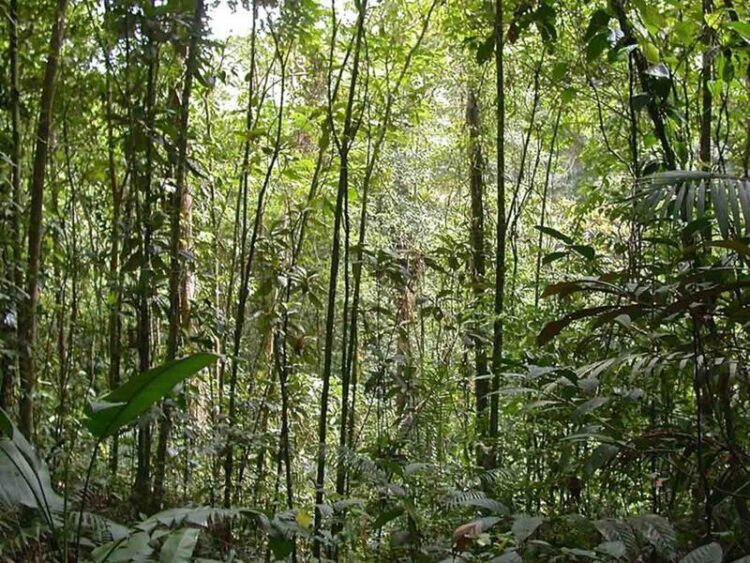Let tropical forests grow again

Relatively young secondary forest in Costa Rica with similar-sized slender stems.
Foto: Robin Chazdon
Tropical forests are vanishing at an alarming rate through deforestation, but also have the potential to regrow naturally on abandoned lands. A study published this week in Science shows that regrowing tropical forests recover surprisingly fast. After 20 years, characteristic attributes have recovered by an average of nearly 80% of old-growth forest values.
The study led by Wageningen University with support from the German Centre for Integrative Biodiversity Research (iDiv) concludes that natural regeneration is a low-cost, nature-based solution for climate change mitigation and biodiversity conservation.
The international team of tropical ecologists analysed how twelve attributes recover during the natural process of forest regeneration, and how their recovery is interrelated using 77 landscapes and more than 2200 forest plots across tropical America and West Africa.
Lead author Prof Lourens Poorter from Wageningen University says: “While it is essential to actively protect old-growth forests and stop further deforestation, tropical forests have the potential to regrow naturally in already deforested areas on abandoned lands. These regrowing forests cover vast areas and can contribute to local and global targets for ecosystem restoration. They provide global benefits for climate change mitigation and adaptation and biodiversity conservation, and many other services for local people, such as water, fuel, wood, and non-timber forest products”.
The researchers found that these secondary forests recover surprisingly fast, indicating that there are large short-term benefits of natural tropical forest restoration. Yet, the speed of recovery differs strongly across forest attributes: Recovery to 90% of old-growth forest values is fastest for soil fertility (less than 10 years) and for plant functioning (less than 25 years), intermediate for structure and species diversity (25-60 years), and slowest for aboveground biomass and species composition (more than 120 years).
Second author, Dr Dylan Craven, a former researcher at iDiv and Helmholtz Centre for Environmental Research (UFZ), now at Universidad Mayor in Chile, says: “We analysed how the recovery of different forest attributes was interrelated. We found that maximum tree size, variation in forest structure, and tree species richness are robust indicators of recovery of multiple forest attributes. These three indicators are relatively easy to measure and can be used to monitor forest restoration. You can now already monitor tree size and variation over large areas and time scales, using remote sensing.”
Secondary forests are forests that regrow naturally after nearly complete removal of forest cover for anthropogenic use (usually for shifting cultivation, conventional cropping or cattle ranching). In tropical Latin America, secondary forests cover as much as 28% of the land area.
”Given the local and global importance of secondary forests and their rapid recovery after 20 years, we encourage adoption of (assisted) natural regeneration as a low-cost, nature-based solution,” says co-author Dr Nadja Rüger from iDiv and Leipzig University. This could be a simple but efficient measure to meet the goals of the United Nations’ sustainable development, the UN decade of Ecosystem Restoration (2020-2030), UN framework on climate change mitigation (COP 26), and the Convention of Biological Diversity (COP 15).
Bruno Hérault, last author from CIRAD, Ivory Coast adds: “Yet, there is no silver bullet to restoration, and a mix of natural and active restoration may be needed. There is a whole gradient of solutions, ranging from natural regeneration, assisted natural regeneration, agroforestry, to plantations. The optimal solution depends on local site conditions, the local people, and their needs. By using such a mix of approaches we can create more natural, biodiverse, and resilient landscapes.”
This research was financed, amongst others, by the European Research Council Advanced Grant PANTROP and by Deutsche Forschungsgemeinschaft (DFG; FZT-118). It is a product of the sDiv working group sUCCESS. iDiv’s synthesis centre sDiv supports working group meetings where international scientists work together on scientific issues.
Wissenschaftliche Ansprechpartner:
Prof Dr Lourens Poorter
Wageningen University and Research, Netherlands
Phone: +31 317 486216
Email: Lourens.Poorter@wur.nl
Dr Nadja Rüger
German Centre for Integrative Biodiversity Research (iDiv) Halle-Jena-Leipzig
Leipzig University
Phone: +49 341 9733168
Email: nadja.rueger@idiv.de
Originalpublikation:
Lourens Poorter et al. (2021): Multi-dimensional tropical forest recovery, Science, https://www.science.org/doi/10.1126/science.abh3629
Media Contact
All latest news from the category: Ecology, The Environment and Conservation
This complex theme deals primarily with interactions between organisms and the environmental factors that impact them, but to a greater extent between individual inanimate environmental factors.
innovations-report offers informative reports and articles on topics such as climate protection, landscape conservation, ecological systems, wildlife and nature parks and ecosystem efficiency and balance.
Newest articles

Innovative 3D printed scaffolds offer new hope for bone healing
Researchers at the Institute for Bioengineering of Catalonia have developed novel 3D printed PLA-CaP scaffolds that promote blood vessel formation, ensuring better healing and regeneration of bone tissue. Bone is…

The surprising role of gut infection in Alzheimer’s disease
ASU- and Banner Alzheimer’s Institute-led study implicates link between a common virus and the disease, which travels from the gut to the brain and may be a target for antiviral…

Molecular gardening: New enzymes discovered for protein modification pruning
How deubiquitinases USP53 and USP54 cleave long polyubiquitin chains and how the former is linked to liver disease in children. Deubiquitinases (DUBs) are enzymes used by cells to trim protein…



